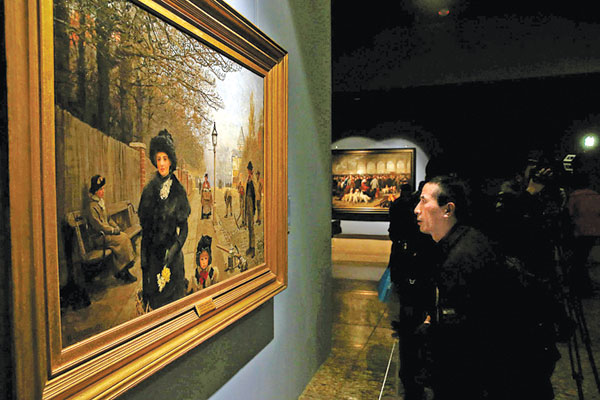
 |
|
The ongoing British art exhibition features Spring Morning: Haverstock Hill, by George Clausen (1852-1944). [Photo by Jiang Dong/China Daily] |
Exhibition reveals how the UK emerged into the modern era over 300 years, Lin Qi reports.
A display of 80 works of art is far from enough to summarize the diversity and complexity of British art since the Industrial Revolution. It's enlightening, however, as each item gives "a glimpse of particular preoccupation on the part of the artist", says Christopher Newall, art historian and co-curator of the exhibition Towards Modernity: Three Centuries of British Art.
"We intend to integrate those works as clues to the British mentality, British culture in a larger sense than just in the terms of artistic development," he says.
The month-long exhibition, now at the Beijing World Art Museum, presents a wealth of oil paintings, sculptures, sketches, prints and watercolors, which were created from the mid-18th century to today. They range from traditional historical and religious motifs to landscape and portraiture. The subjects are not only nobles and celebrities, but also the emerging middle-class and workers.
Artists involved include William Turner, Lucian Freud and Henry Moore - all familiar to Chinese art lovers, as well as members of the less-known Pre-Raphaelite Brotherhood.
Li Jianqun, professor of the Central Academy of Fine Arts, suggested the theme of the exhibition as "towards modernity" when she was invited to co-curate the exhibition. She says it's because the exhibits reveal the Industrial Revolution's profound influence on British society.
"The revolution prompted the UK, formerly a traditional agricultural country, to become an industrial society. The tremendous changes were reflected in fine arts, lifestyle, tastes and people's perspectives of the world. The country used to be quite conservative, but over the past 300 years, its arts have entered the ranks of avant-garde," she says.
The exhibits come from 18 public museums in northwest England's greater Manchester. They demonstrate the legacy of artist patronage and art collecting in the northern industrial cities that burgeoned in the revolution. Food for thought, perhaps, for China's nouveau rich.
"New wealthy industrialists believed that life should be improved by works of art, that the arts could be passed down and shared with the public," Newall says.
Bury paper manufacturer Thomas Wrigley was one of them, whose collection formed the Bury Art Museum. It brings to the exhibition 10 attractions such as Turner's Calais Sands at Low Water: Fishers Collecting Bait and George Clausen's Spring Morning: Haverstock Hill.